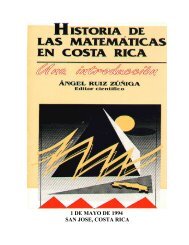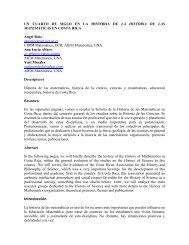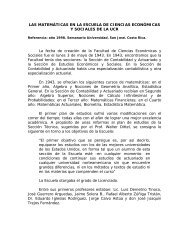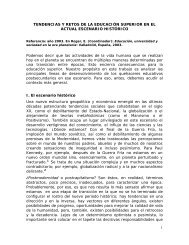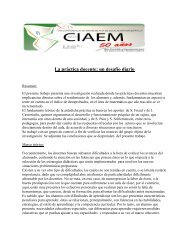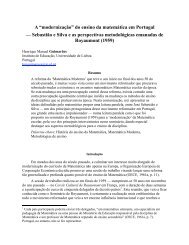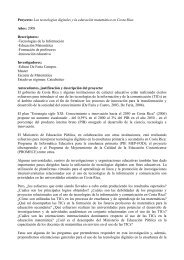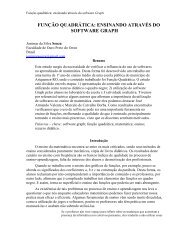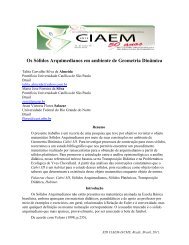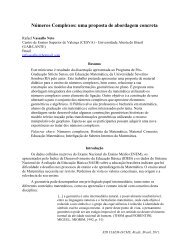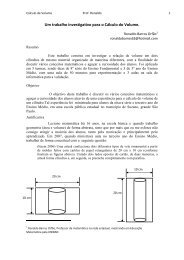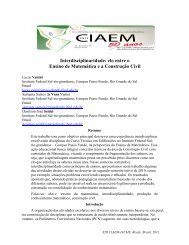Reform of the construction of the number system with ... - CIMM
Reform of the construction of the number system with ... - CIMM
Reform of the construction of the number system with ... - CIMM
You also want an ePaper? Increase the reach of your titles
YUMPU automatically turns print PDFs into web optimized ePapers that Google loves.
ZDM Ma<strong>the</strong>matics Education (2007) 39:31–38<br />
DOI 10.1007/s11858-006-0003-2<br />
ORIGINAL ARTICLE<br />
<strong>Reform</strong> <strong>of</strong> <strong>the</strong> <strong>construction</strong> <strong>of</strong> <strong>the</strong> <strong>number</strong> <strong>system</strong><br />
<strong>with</strong> reference to Gottlob Frege<br />
Heinz Griesel<br />
Accepted: 3 November 2006 / Published online: 24 January 2007<br />
Ó FIZ Karlsruhe 2007<br />
Abstract Due to missing ontological commitments<br />
Frege rejected Hilbert’s Fundamentals <strong>of</strong> Geometry as<br />
well as <strong>the</strong> <strong>construction</strong> <strong>of</strong> <strong>the</strong> <strong>system</strong> <strong>of</strong> real <strong>number</strong>s<br />
by Dedekind and Cantor. Almost all <strong>of</strong> school ma<strong>the</strong>matics<br />
is ontologically committed. Therefore, H.-G.<br />
Steiner considered Frege’s viewpoint <strong>of</strong> ma<strong>the</strong>matics<br />
fundamentals, refined by Tarski’s semantics, as suitable<br />
for math education. Frege committed <strong>number</strong>s ontologically<br />
by using measurement to define <strong>number</strong>s. He<br />
invented <strong>the</strong> concept <strong>of</strong> quantitative domain (Größengebiet),<br />
which – it is now known by re<strong>construction</strong><br />
<strong>of</strong> that concept by <strong>the</strong> New-Fregean Movement –<br />
agrees <strong>with</strong> <strong>the</strong> concept <strong>of</strong> quantity domain (Größenbereich)<br />
as established in <strong>the</strong> German reform <strong>of</strong> <strong>the</strong><br />
application-oriented <strong>construction</strong> <strong>of</strong> <strong>the</strong> <strong>system</strong> <strong>of</strong> real<br />
<strong>number</strong>s. Concepts <strong>of</strong> quantity (ratio-scale) and interval-scale<br />
in comparative measurement <strong>the</strong>ory – going<br />
beyond Frege – show <strong>the</strong> way how <strong>the</strong> negative <strong>number</strong>s<br />
can be ontologically committed and <strong>the</strong> operations<br />
<strong>of</strong> addition and multiplication can be included. In<br />
this work it is shown how Frege’s viewpoint <strong>of</strong> ma<strong>the</strong>matics<br />
fundamentals, as propagated by H.-G. Steiner,<br />
can be better implemented in <strong>the</strong> current <strong>construction</strong><br />
<strong>of</strong> <strong>the</strong> <strong>system</strong> <strong>of</strong> real <strong>number</strong>s in school.<br />
H. Griesel (&)<br />
Fachbereich Ma<strong>the</strong>matik/Informatik,<br />
Universität Kassel, Postfach 10 13 80,<br />
34109 Kassel, Germany<br />
e-mail: hgriesel@web.de<br />
1 Appropiate foundational viewpoint for math<br />
education: objective <strong>of</strong> this work<br />
In 1964, Steiner (1964, 1965a) pointed out a correspondence<br />
between Frege and Hilbert, commenting on<br />
its essence in detail. Frege criticizes Hilbert’s foundations<br />
<strong>of</strong> geometry. Using a contemporary philosophical<br />
term, Frege’s critique can be summarized as follows:<br />
There is a lack <strong>of</strong> ontological commitments, meaning<br />
<strong>the</strong>re is no connection between geometry and reality.<br />
Frege even claimed that ontological commitments are<br />
a substantial component <strong>of</strong> all ma<strong>the</strong>matics. In school<br />
ma<strong>the</strong>matics ontological commitments may be absent<br />
in only a few places. They are anyhow essential for<br />
application-oriented ma<strong>the</strong>matics instruction. In this<br />
context Steiner (1965a, p. 45) states: ‘‘Frege’s viewpoint,<br />
refined by modern semantics, can serve excellently<br />
as <strong>the</strong> scientific <strong>the</strong>oretical background’’. (‘‘Als<br />
wissenschafts<strong>the</strong>oretischer Hintergrund hierzu kann in<br />
ausgezeichneter Weise der durch die moderne Semantik<br />
verfeinerte Standpunkt Freges dienen’’). Steiner<br />
considered Tarsky’s semantics as refinement. Also,<br />
in <strong>the</strong> disagreement <strong>with</strong> his PhD mentor, Laugwitz, he<br />
expressed <strong>the</strong> same opinion (Steiner, 1965b). He observed<br />
this standpoint implemented in <strong>the</strong> modern<br />
<strong>the</strong>ory <strong>of</strong> equations, to which he had provided important<br />
aspects (Steiner, 1961).<br />
One <strong>of</strong> <strong>the</strong> central topics <strong>of</strong> school ma<strong>the</strong>matics is<br />
<strong>the</strong> <strong>construction</strong> <strong>of</strong> <strong>the</strong> <strong>number</strong> <strong>system</strong>. It is, like most<br />
<strong>of</strong> <strong>the</strong> o<strong>the</strong>r parts <strong>of</strong> school ma<strong>the</strong>matics, ontologically<br />
committed. Therefore, it is <strong>the</strong> main objective <strong>of</strong> this<br />
work to bring toge<strong>the</strong>r Frege’s consideration <strong>with</strong> <strong>the</strong><br />
German reforms <strong>of</strong> <strong>the</strong> <strong>construction</strong> <strong>of</strong> <strong>the</strong> <strong>number</strong><br />
<strong>system</strong> which were established in <strong>the</strong> 1960s and 1970s<br />
<strong>with</strong>out reference to Frege.<br />
123
32 H. Griesel<br />
In this context we have to question if all elements <strong>of</strong><br />
Frege’s <strong>construction</strong> <strong>of</strong> <strong>the</strong> <strong>number</strong> <strong>system</strong> are really<br />
ontologically committed and if <strong>the</strong>y are conceptually<br />
uniform. We have also to explore <strong>the</strong> weaknesses <strong>of</strong><br />
<strong>the</strong> aforementioned German projects and to find<br />
homogeneous aspects <strong>of</strong> <strong>the</strong> <strong>construction</strong> <strong>of</strong> <strong>the</strong> <strong>number</strong><br />
<strong>system</strong> in school.<br />
2 Frege’s application-oriented <strong>construction</strong><br />
<strong>of</strong> <strong>the</strong> real <strong>number</strong> <strong>system</strong><br />
2.1 Frege’s critique <strong>of</strong> Dedekind’s and Cantor’s<br />
<strong>construction</strong> <strong>of</strong> <strong>the</strong> real <strong>number</strong> <strong>system</strong><br />
It is too little known that Frege <strong>with</strong> similar arguments<br />
as against Hilbert refuted Dedekind’s and Cantor’s<br />
<strong>construction</strong> <strong>of</strong> <strong>the</strong> <strong>number</strong> <strong>system</strong>. He raised his main<br />
criticism demanding that real <strong>number</strong>s used for measuring<br />
should be involved in <strong>the</strong>ir definition (Kutschera,<br />
1989, p. 120). Frege writes literally for his own<br />
intentions (Frege, 1903, p. 157): ‘‘We simultaneously<br />
avoid <strong>the</strong> deficiency that <strong>the</strong> measuring ei<strong>the</strong>r does not<br />
occur at all or that measuring and <strong>number</strong>s are patched<br />
toge<strong>the</strong>r <strong>with</strong>out internal consistency reasonable in <strong>the</strong><br />
essence <strong>of</strong> <strong>the</strong> <strong>number</strong> itself.’’ (‘‘Wir vermeiden zugleich<br />
den bei diesen hervortretenden Mangel, dass das<br />
Messen entweder gar nicht vorkommt oder ohne inneren<br />
im Wesen der Zahl selbst begründeten Zusammenhang<br />
rein äußerlich angeflickt wird.’’) Obviously<br />
Frege regarded measuring as <strong>the</strong> means <strong>with</strong> which <strong>the</strong><br />
ontological commitments <strong>of</strong> <strong>the</strong> <strong>number</strong>s are produced.<br />
In fact, Dedekind and Cantor did not reference<br />
measuring at all. The <strong>construction</strong> <strong>of</strong> <strong>the</strong> <strong>number</strong> <strong>system</strong>s<br />
by both, and later by Landau (1930) as well as in<br />
<strong>the</strong> excellent book from Oberschelp (1968) all took<br />
place <strong>with</strong>out ontological commitments.<br />
2.2 Frege’s own <strong>the</strong>ory <strong>of</strong> <strong>the</strong> <strong>construction</strong><br />
<strong>of</strong> <strong>the</strong> real <strong>number</strong> <strong>system</strong><br />
Unlike geometry, Frege attempted to fulfill <strong>the</strong> demand<br />
for ontological commitments during his <strong>construction</strong><br />
<strong>of</strong> <strong>the</strong> real <strong>number</strong> <strong>system</strong>. The <strong>the</strong>ory <strong>of</strong> <strong>the</strong><br />
natural <strong>number</strong>s is represented in <strong>the</strong> book The<br />
Foundations <strong>of</strong> Arithmetic (Frege, 1884), <strong>with</strong> fur<strong>the</strong>r<br />
<strong>construction</strong> <strong>of</strong> <strong>the</strong> <strong>number</strong> <strong>system</strong> in <strong>the</strong> two-volume<br />
work, The Basic Laws <strong>of</strong> Arithmetic (Frege, 1893,<br />
1903). The natural <strong>number</strong>s are introduced as finite<br />
cardinals while <strong>the</strong> positive rational and real <strong>number</strong>s<br />
are coefficients <strong>of</strong> measure. In this way a clear conceptual<br />
difference between both kinds <strong>of</strong> <strong>number</strong>s<br />
appears, which we will be preoccupied <strong>with</strong> later.<br />
123<br />
In order to include <strong>the</strong> measuring according to his<br />
own demand <strong>of</strong> ontological commitments, Frege was<br />
<strong>the</strong> first to have <strong>the</strong> idea to introduce <strong>the</strong> concept <strong>of</strong><br />
quantitative domain. He writes (Frege, 1903, p. 159):<br />
‘‘Something is a quantity not alone for itself but only if<br />
it is an element <strong>with</strong> o<strong>the</strong>r objects <strong>of</strong> a class that is a<br />
quantitative domain.’’ (‘‘Etwas ist eine Größe nicht für<br />
sich allein, sondern nur, s<strong>of</strong>ern es mit anderen Gegenständen<br />
einer Klasse angehört, die ein Größengebiet<br />
ist.’’) Lengths, areas, volumes, durations,<br />
masses and angles form quantitative domains.<br />
Frege’s considerations about <strong>the</strong> definition <strong>of</strong> <strong>number</strong>s<br />
are difficult to comprehend because Frege uses<br />
<strong>the</strong> two-dimensional Begriffsschrift (concept-script) for<br />
<strong>the</strong> formalization <strong>of</strong> <strong>the</strong> ma<strong>the</strong>matical facts introduced<br />
by himself, which is not familiar to contemporary<br />
ma<strong>the</strong>maticians and because Frege’s position is concept-<strong>the</strong>oretical<br />
ra<strong>the</strong>r than set-<strong>the</strong>oretical. Fur<strong>the</strong>rmore,<br />
his considerations are incomplete. Originally he<br />
had planned ano<strong>the</strong>r third volume that was not published<br />
after Russell discovered a contradiction in Frege’s<br />
logical <strong>system</strong> now known as Russell’s paradox<br />
(Russellsche Antinomie).<br />
2.3 The re<strong>construction</strong> <strong>of</strong> Frege’s considerations<br />
in <strong>the</strong> new-Fregean movement<br />
Since some years <strong>the</strong>re has been an attempt to revive<br />
Frege’s considerations (Demopolous, 1995; Hale and<br />
Wright, 2001;). Main representatives <strong>of</strong> this Neo-Fregeanism<br />
are <strong>the</strong> philosophers Crispin Wright (St. Andrews)<br />
and Bob Hale (formerly Glasgow, now<br />
Sheffield). Thereby, Frege’s <strong>construction</strong> <strong>of</strong> <strong>the</strong> <strong>number</strong><br />
<strong>system</strong> was reconstructed <strong>with</strong> <strong>the</strong> usual means <strong>of</strong><br />
structural ma<strong>the</strong>matics. The concept <strong>of</strong> quantitative<br />
domain introduced by Frege is defined as a linear-ordered,<br />
Abelian semigroup, which suffices <strong>the</strong> fur<strong>the</strong>r<br />
condition a < b , $c a + c = b (Hale, 2001, p. 405;<br />
Stein, 1995, p. 339).<br />
2.4 Deficits in Frege’s <strong>construction</strong> <strong>of</strong> <strong>the</strong> <strong>number</strong><br />
<strong>system</strong><br />
As previously mentioned, Frege did not have any<br />
uniform concept <strong>of</strong> <strong>number</strong>. That is beyond doubt a<br />
first deficit. Fur<strong>the</strong>rmore, Frege had insufficiently fulfilled<br />
his own demand to involve measuring in <strong>the</strong><br />
definition <strong>of</strong> <strong>number</strong>s. One can consider this demand<br />
fulfilled for <strong>the</strong> natural and <strong>the</strong> positive rational <strong>number</strong>s.<br />
The negative <strong>number</strong>s on <strong>the</strong> o<strong>the</strong>r hand are<br />
introduced <strong>with</strong>out involving measuring and, <strong>the</strong>refore,<br />
<strong>with</strong>out ontological commitments. Additionally, Frege<br />
neglected to consequently meet <strong>the</strong> stipulations <strong>of</strong>
<strong>Reform</strong> <strong>of</strong> <strong>the</strong> <strong>construction</strong> <strong>of</strong> <strong>the</strong> <strong>number</strong> <strong>system</strong> <strong>with</strong> reference to Gottlob Frege 33<br />
including measuring in <strong>the</strong> definitions <strong>of</strong> <strong>the</strong> introduced<br />
operations <strong>of</strong> addition and multiplication. Both<br />
definitions are defined free from measuring and<br />
<strong>the</strong>refore are cut <strong>of</strong>f from ontological commitments.<br />
Hence, three deficits appear in <strong>the</strong> application-oriented<br />
<strong>construction</strong> <strong>of</strong> <strong>the</strong> <strong>number</strong> <strong>system</strong> according to<br />
Frege:<br />
– There is no uniform <strong>number</strong> concept.<br />
– The negative <strong>number</strong>s are not defined by involving<br />
measuring.<br />
– The operations addition and multiplication are not<br />
defined by involving measuring.<br />
2.5 Rehabilitation <strong>of</strong> <strong>the</strong> principles <strong>of</strong> abstraction<br />
by Neo-Fregeanism<br />
The Neo-Fregeanism has also brought a rehabilitation<br />
<strong>of</strong> <strong>the</strong> abstraction principles (also called definitions by<br />
abstraction) and that <strong>the</strong>y can be articulated as legitimate<br />
foundations for ma<strong>the</strong>matical <strong>the</strong>ories. That<br />
means: If ~ is an equivalence relation, it is possible to<br />
proceed mentally to that abstraction which all elements<br />
<strong>of</strong> an equivalence class have in common and mentally<br />
act <strong>with</strong> this common property E(x) <strong>of</strong> <strong>the</strong> element x as a<br />
ma<strong>the</strong>matical object (cf. <strong>the</strong> full discussion in Fine, 1998;<br />
about 100 pages). It is <strong>the</strong>n valid: E(x) =E(y) , x~y<br />
These properties as abstractions must be treated as<br />
objects in <strong>the</strong>ir own right. In modern ma<strong>the</strong>matics it<br />
has been customary to identify <strong>the</strong>se abstractions <strong>with</strong><br />
<strong>the</strong> equivalence classes. That is in general not practical<br />
in math education.<br />
In school ma<strong>the</strong>matics, <strong>the</strong>se principles <strong>of</strong> abstraction<br />
are unconsciously used in <strong>the</strong> quantities length,<br />
area, volume, duration, mass and <strong>the</strong> finite cardinals.<br />
Each <strong>of</strong> <strong>the</strong>se quantities has a set <strong>of</strong> objects, in which<br />
an equivalence relation is defined.<br />
To <strong>the</strong> quantity length appertain as objects <strong>the</strong> line<br />
segments. The equivalence relation is congruent.<br />
The quantity area has surfaces as objects. The<br />
equivalence relation is equidecomposable (decomposed<br />
into parts so that <strong>the</strong> parts are two-by-two congruent,<br />
in German: zerlegungsgleich).<br />
The quantity duration has events as objects. The<br />
equivalence relation is takes as long as.<br />
The quantities volume and mass have <strong>the</strong> same objects,<br />
namely bodies. But, <strong>the</strong> equivalent relations are<br />
different. In <strong>the</strong> case <strong>of</strong> volume, <strong>the</strong>re is <strong>the</strong> equivalence<br />
relation equivoluminous. A equivoluminous B means<br />
that when fluid completely fills A or B it is possible to<br />
pour fluid from A to B and from B to A <strong>with</strong>out any<br />
spillage or when A and B are immersed into a body <strong>of</strong><br />
fluid, <strong>the</strong> fluid level is equally raised each time.<br />
The quantity mass has <strong>the</strong> equivalence relation<br />
equimassive. A equimassive B means that <strong>the</strong>re is<br />
balance if <strong>the</strong> bodies A and B are on <strong>the</strong> balance scales.<br />
The quantity finite cardinal has finite sets as objects.<br />
The equivalence relation is equinumerous (<strong>the</strong>re is a<br />
one-to-one correspondence). This abstraction principle<br />
is also called Hume’s Principle. It was already used by<br />
Frege.<br />
In <strong>the</strong> next step, one goes in school ma<strong>the</strong>matics<br />
mentally from <strong>the</strong>se equivalence relations to <strong>the</strong><br />
abstractions, which have in common <strong>the</strong> equivalent<br />
objects in each case. These abstractions are called <strong>the</strong><br />
quantity values, respectively, in <strong>the</strong> special cases lengthvalues,<br />
area-values, volume-values, duration-values,<br />
mass-values, finite cardinal-values.<br />
The quantities, <strong>the</strong>refore, are interpreted as special<br />
mappings <strong>with</strong> a set <strong>of</strong> objects as domain. The values <strong>of</strong><br />
<strong>the</strong> quantity form <strong>the</strong> range <strong>of</strong> that mapping. The<br />
mapping is also called a scale. It is valid for instance for<br />
<strong>the</strong> quantity length L: L(s) =L(s¢) , s congruent s’<br />
and for <strong>the</strong> quantity finite cardinal N: N(A) =N(B) ,<br />
A equinumerous B<br />
Frege himself has used as an example <strong>the</strong> lines <strong>with</strong><br />
<strong>the</strong> equivalence relation parallel. The common<br />
abstraction <strong>of</strong> parallel lines is <strong>the</strong> direction <strong>of</strong> <strong>the</strong> lines.<br />
The direction <strong>of</strong> lines is not a quantity. It is a nominalscale.<br />
3 <strong>Reform</strong>s <strong>of</strong> <strong>the</strong> <strong>construction</strong> <strong>of</strong> <strong>the</strong> <strong>number</strong> <strong>system</strong><br />
in German school ma<strong>the</strong>matics<br />
3.1 Scientific orientation applied to <strong>the</strong><br />
<strong>construction</strong> <strong>of</strong> <strong>the</strong> <strong>number</strong> <strong>system</strong><br />
In 1960–1970s, Germany took part in <strong>the</strong> worldwide<br />
curriculum reform <strong>of</strong> ma<strong>the</strong>matical instruction. An<br />
important feature <strong>of</strong> <strong>the</strong> reform was <strong>the</strong> scientific orientation<br />
<strong>of</strong> <strong>the</strong> curricula, that is how contemporary<br />
ma<strong>the</strong>matics should be presented. Under this point <strong>of</strong><br />
view, <strong>the</strong>re was also a question <strong>of</strong> <strong>the</strong> <strong>construction</strong> <strong>of</strong><br />
<strong>the</strong> <strong>number</strong> <strong>system</strong>, in particular <strong>the</strong> calculation <strong>with</strong><br />
fractions, that is, <strong>the</strong> introduction <strong>of</strong> <strong>the</strong> positive rational<br />
<strong>number</strong>s and <strong>the</strong>ir operations addition and<br />
multiplication. Never<strong>the</strong>less, <strong>the</strong> ma<strong>the</strong>matics didacticians<br />
<strong>of</strong> <strong>the</strong> Federal Republic <strong>of</strong> Germany agreed that<br />
a very strict scientific orientation as dictated in <strong>the</strong><br />
GDR was educationally not reasonable. The <strong>construction</strong><br />
<strong>of</strong> <strong>the</strong> <strong>number</strong> <strong>system</strong> must indeed be ma<strong>the</strong>matically<br />
well-founded, but fur<strong>the</strong>rmore genetic,<br />
oriented at <strong>the</strong> developmental and thinking level <strong>of</strong> <strong>the</strong><br />
students, and application-oriented from <strong>the</strong> beginning<br />
(Griesel, 2001).<br />
123
34 H. Griesel<br />
3.2 Positive rational <strong>number</strong>s as operators<br />
on quantity domains<br />
The ma<strong>the</strong>matical foundations <strong>of</strong> <strong>the</strong> reform <strong>of</strong> <strong>the</strong><br />
<strong>construction</strong> <strong>of</strong> <strong>the</strong> <strong>number</strong> <strong>system</strong> were researched by<br />
Lugowski (1962), Kirsch (1970), Pickert (1968) and<br />
Griesel (1968, 1971, 1973a, b, 1974). In order to achieve<br />
application-orientation, Lugowski (1962) introduced,<br />
<strong>with</strong>out knowledge <strong>of</strong> Frege’s considerations, <strong>the</strong><br />
concept <strong>of</strong> quantity domain. The definition, going back<br />
to Kirsch, <strong>of</strong> a quantity domain as a linear-ordered,<br />
Abelian semi-group, <strong>with</strong> <strong>the</strong> additional condition<br />
a < b , $c a+ c = b is now used (Kirsch, 1970, p. 43).<br />
This was developed independent <strong>of</strong> Frege’s deliberations<br />
30 years before <strong>the</strong> re<strong>construction</strong> <strong>of</strong> Frege’s<br />
considerations by <strong>the</strong> Neo-Fregeanism. It is remarkable<br />
that <strong>the</strong> concept <strong>of</strong> quantity domain according to<br />
Kirsch agrees <strong>with</strong> <strong>the</strong> concept <strong>of</strong> quantitative domain<br />
according to Frege.<br />
Also Hans Georg Steiner pursued <strong>the</strong>se considerations<br />
<strong>with</strong> interest although he himself has not intervened<br />
actively. After all, a report about this German<br />
development in Educational Studies (Steiner, 1969)<br />
was written by him.<br />
The positive rational <strong>number</strong>s were introduced as<br />
operators on divisible quantity domains (Griesel,<br />
1973a). For instance, <strong>the</strong> <strong>number</strong> ’ became a chain <strong>of</strong><br />
<strong>the</strong> stretcher 3 <strong>with</strong> <strong>the</strong> shrinker :4. That had <strong>the</strong><br />
advantage <strong>of</strong> machanical concretization. The forming<br />
<strong>of</strong> fraction-parts could be regarded as applying an<br />
operator to a value <strong>of</strong> a quantity and multiplication as<br />
connecting fraction operators in series dynamically.<br />
3.3 Problems <strong>with</strong> <strong>the</strong> implementation<br />
<strong>of</strong> <strong>the</strong> curricula<br />
During <strong>the</strong> implementation <strong>of</strong> <strong>the</strong> curricula <strong>the</strong>re were<br />
difficulties in understanding in <strong>the</strong> majority <strong>of</strong> <strong>the</strong> classes.<br />
The embedding <strong>of</strong> <strong>the</strong> natural <strong>number</strong>s into <strong>the</strong> new<br />
rational <strong>number</strong>s was not understood by many students.<br />
That was not surprising since <strong>the</strong> students were acquainted<br />
<strong>with</strong> <strong>the</strong> natural <strong>number</strong>s for 5 years as finite<br />
cardinals. Now <strong>the</strong>se <strong>number</strong>s should abruptly be<br />
operators. Also, <strong>the</strong> proposal <strong>of</strong> Kirsch to interpret <strong>the</strong><br />
natural <strong>number</strong>s in a specific curriculum as operators<br />
before beginning <strong>with</strong> <strong>the</strong> introduction <strong>of</strong> <strong>the</strong> rational<br />
<strong>number</strong>s was not successful (Griesel, 1973a). Therefore,<br />
<strong>the</strong> introduction <strong>of</strong> <strong>the</strong> natural <strong>number</strong>s as operators<br />
was stopped. The authors <strong>of</strong> <strong>the</strong> textbooks returned to a<br />
more conventional introduction. But, <strong>the</strong>y were at least<br />
able to improve <strong>the</strong>ir curricula by some results <strong>of</strong><br />
didactical research like <strong>the</strong> quasi-cardinal aspect <strong>of</strong> <strong>the</strong><br />
positive rational <strong>number</strong>s (see Sect. 3.4).<br />
123<br />
3.4 Basic structure <strong>of</strong> <strong>the</strong> current curricula<br />
for <strong>the</strong> <strong>construction</strong> <strong>of</strong> <strong>the</strong> <strong>number</strong> <strong>system</strong><br />
The current curricula for <strong>the</strong> <strong>construction</strong> <strong>of</strong> <strong>the</strong> <strong>number</strong><br />
<strong>system</strong> in Germany have <strong>the</strong> following basic structure:<br />
From <strong>the</strong> first to fifth school years, <strong>the</strong> natural <strong>number</strong>s<br />
are regarded as finite cardinals, <strong>the</strong>refore, as values <strong>of</strong> a<br />
quantity. Addition and multiplication are also introduced<br />
in connection <strong>with</strong> this quantity. A detachment<br />
from <strong>the</strong> idea <strong>of</strong> finite cardinals, and <strong>the</strong>refore, a treatment<br />
<strong>of</strong> natural <strong>number</strong>s as objects in <strong>the</strong>ir own right<br />
takes place in <strong>the</strong> <strong>the</strong>ory <strong>of</strong> divisibility in <strong>the</strong> fifth school<br />
year <strong>with</strong> <strong>the</strong> concepts divisor, multiple, greatest common<br />
divisor, least common multiple, and prime <strong>number</strong>.<br />
In <strong>the</strong> <strong>the</strong>ory <strong>of</strong> fractions in <strong>the</strong> sixth school year <strong>the</strong><br />
positive rational <strong>number</strong>s are understood as ratios <strong>of</strong> a<br />
part to a whole (in German: Anteile) and <strong>the</strong>refore also<br />
as values <strong>of</strong> a quantity. Besides <strong>the</strong> difficulties, given by<br />
<strong>the</strong> concepts <strong>of</strong> natural <strong>number</strong>s as finite cardinals and<br />
<strong>the</strong> positive rational <strong>number</strong>s as ratios <strong>of</strong> a part to a<br />
whole are reduced by quasi-cardinal considerations<br />
(Griesel, 1981). For instance, a fraction like ’ is in this<br />
case understood as 3 fourths, <strong>the</strong>refore, as a cardinal <strong>of</strong><br />
fourths. But it is not possible to give reason for <strong>the</strong> rule<br />
<strong>of</strong> reducing fractions to lower respective higher terms<br />
by <strong>the</strong> quasi-cardinal aspect except by <strong>the</strong> intuitive<br />
concept <strong>of</strong> ratio <strong>of</strong> a part to a whole.<br />
The picture given by <strong>the</strong> negative <strong>number</strong>s is not so<br />
homogenous. There are several manners and forms <strong>of</strong><br />
<strong>the</strong> negative <strong>number</strong>s in <strong>the</strong> curricula. References are<br />
found in Postel (2005) and Griesel (2003).<br />
There are also no homogenous characteristics <strong>of</strong> <strong>the</strong><br />
operations addition and multiplication that can be<br />
found in all kinds <strong>of</strong> <strong>number</strong>s.<br />
The multiplication <strong>of</strong> natural <strong>number</strong>s is introduced<br />
in close relationship to <strong>the</strong> interpretation <strong>of</strong> <strong>the</strong>se<br />
<strong>number</strong>s as finite cardinals. 3 4, for example means<br />
<strong>the</strong> cardinal <strong>of</strong> a set, which is <strong>the</strong> set-<strong>the</strong>oretical union<br />
<strong>of</strong> three disjoint sets each <strong>with</strong> four elements.<br />
The multiplication <strong>of</strong> positive rational <strong>number</strong>s is<br />
introduced in close relationship to <strong>the</strong> interpretation <strong>of</strong><br />
<strong>the</strong>se <strong>number</strong>s as ratios <strong>of</strong> a part to a whole. 2/3 5/8<br />
for example means that a ratio which is obtained as<br />
follows: One forms 5/8 from a whole and forms 2/3<br />
from that part. The ratio <strong>of</strong> this new part to <strong>the</strong> original<br />
whole is <strong>the</strong>n 2/3 5/8. This is <strong>the</strong> classical interpretation<br />
<strong>of</strong> <strong>the</strong> multiplication as forming portion-from. In<br />
brief: times means from. The rule <strong>of</strong> multiplication <strong>of</strong><br />
fractions (in brief: numerator times numerator,<br />
denominator times denominator) <strong>the</strong>n can be proved.<br />
The introductions <strong>of</strong> multiplication <strong>of</strong> <strong>the</strong> natural<br />
and <strong>the</strong> positive rational <strong>number</strong>s are clearly application-oriented.<br />
The relationship under each o<strong>the</strong>r must
<strong>Reform</strong> <strong>of</strong> <strong>the</strong> <strong>construction</strong> <strong>of</strong> <strong>the</strong> <strong>number</strong> <strong>system</strong> <strong>with</strong> reference to Gottlob Frege 35<br />
remain unclear because it is a question <strong>of</strong> principally<br />
different things. The difficulties in <strong>the</strong> curricula arising<br />
<strong>the</strong>re from are reduced by calculation exercises having<br />
fractions <strong>with</strong> a denominator <strong>of</strong> 1. The differences<br />
between finite cardinals and ratios <strong>of</strong> a part to a whole<br />
are downplayed.<br />
The specified deficiencies both <strong>of</strong> Frege and <strong>of</strong> <strong>the</strong><br />
curricula raise <strong>the</strong> question regarding <strong>construction</strong> <strong>of</strong><br />
<strong>the</strong> <strong>number</strong> <strong>system</strong> having uniformity. This is in fact<br />
provided by <strong>the</strong> comparational measurement <strong>the</strong>ory.<br />
4 Didactical implications <strong>of</strong> <strong>the</strong> comparational<br />
measurement <strong>the</strong>ory<br />
4.1 Measuring as multiplicative or additive<br />
comparing<br />
Frege, as mentioned already, had indeed raised <strong>the</strong><br />
demand to include measuring into <strong>the</strong> definition <strong>of</strong><br />
<strong>number</strong>s. But it did not come down to a foundational<br />
analysis <strong>of</strong> measuring, so that Frege and <strong>the</strong> Neo-Fregeanism<br />
did not clarify how quantities, measuring and<br />
<strong>number</strong>s are related toge<strong>the</strong>r. Also, <strong>the</strong> representational<br />
measurement <strong>the</strong>ory (Krantz et al., 1989) could<br />
not answer this question. However, <strong>the</strong> comparational<br />
measurement <strong>the</strong>ory (cf. Griesel, 2005a), which was set<br />
up by <strong>the</strong> author as chairman <strong>of</strong> a working group in<br />
Deutsches Institut für Normung (DIN), does.<br />
According to this <strong>the</strong>ory measuring is primarily <strong>the</strong><br />
multiplicative comparison <strong>of</strong> objects and values <strong>of</strong><br />
quantities (ratio-scales). Numbers are <strong>the</strong> result <strong>of</strong> such<br />
comparisons. Secondly, an enlargement <strong>of</strong> this concept<br />
is measuring as an additive comparison <strong>of</strong> objects and<br />
values <strong>of</strong> interval-scales. The result <strong>of</strong> such an additive<br />
comparison is a quantity value <strong>of</strong> <strong>the</strong> comparison<br />
quantity, which appertains to every interval-scale.<br />
4.2 Specification <strong>of</strong> <strong>the</strong> concepts <strong>of</strong> quantity<br />
(ratio-scale) and measuring<br />
The following definition <strong>of</strong> <strong>the</strong> concept <strong>of</strong> quantity also<br />
involves <strong>the</strong> specification <strong>of</strong> <strong>the</strong> concept <strong>of</strong> measuring.<br />
Remember from Sect. 2.5 in this work that a quantity is<br />
a special mapping <strong>of</strong> a set <strong>of</strong> objects (line segments,<br />
surfaces, bodies, events, finite sets etc.) as <strong>the</strong> domain<br />
<strong>of</strong> <strong>the</strong> mapping and <strong>the</strong> set <strong>of</strong> values as <strong>the</strong> range <strong>of</strong> <strong>the</strong><br />
mapping. This mapping is also called a scale.<br />
4.2.1 Definition <strong>of</strong> a quantity<br />
A mapping <strong>with</strong> <strong>the</strong> domain T and <strong>the</strong> range V is a<br />
quantity (ratio-scale) iff additionally an operation/<strong>with</strong><br />
values in <strong>the</strong> set <strong>of</strong> real <strong>number</strong>s ( „ 0) is defined in <strong>the</strong><br />
range, which fulfils <strong>the</strong> following conditions:<br />
ðx=yÞ ðy=zÞ ¼x=z for all x; y; z 2 V ð1Þ<br />
x=y ¼ 1 ) x ¼ y for all x; y 2 V ð2Þ<br />
It has been proved that this definition is equivalent<br />
to <strong>the</strong> classical definition <strong>of</strong> a ratio-scale given by<br />
Stevens (1946) (Griesel, 1998).<br />
The elements <strong>of</strong> <strong>the</strong> set T are called <strong>the</strong> objects <strong>of</strong> <strong>the</strong><br />
quantity. They are embedded in reality. The elements <strong>of</strong><br />
<strong>the</strong> set V are called <strong>the</strong> values <strong>of</strong> <strong>the</strong> quantity. The<br />
operation / is called measuring or measuring quotient.It<br />
is defined by a measuring procedure. x/y = k (read: x<br />
measured <strong>with</strong> y equals k) means descriptively that y is<br />
contained in x lambda times. In this measurement x is<br />
compared multiplicatively <strong>with</strong> y. The result is <strong>the</strong> real<br />
<strong>number</strong> k ( „ 0). The exact definition <strong>of</strong> <strong>the</strong> measuring<br />
procedure must use <strong>the</strong> objects <strong>of</strong> <strong>the</strong> quantity. Because<br />
<strong>the</strong> objects are interpreted as embedded in reality<br />
measuring is ontologically committed.<br />
New in <strong>the</strong> definition <strong>of</strong> a quantity are especially <strong>the</strong><br />
two conditions (1) and (2). New is not <strong>the</strong> perception <strong>of</strong><br />
<strong>number</strong>s as quotients <strong>of</strong> quantity values. The conditions<br />
specify what measuring in principle is. It can be<br />
proved that <strong>the</strong>y are logical independent <strong>of</strong> each o<strong>the</strong>r.<br />
It is spoken <strong>of</strong> <strong>the</strong> measurement x/y <strong>with</strong> <strong>the</strong> result k.<br />
The two measurements x/y and y/z can be chained<br />
because y appears in both measurements (in <strong>the</strong> second<br />
and in <strong>the</strong> first place, respectively). The result <strong>of</strong> <strong>the</strong><br />
chaining <strong>of</strong> x/y <strong>with</strong> y/z is x/z. Condition (1): (x/y)<br />
(y/z) =x/z <strong>of</strong> <strong>the</strong> definition <strong>of</strong> <strong>the</strong> concept <strong>of</strong> quantity<br />
shows that if <strong>the</strong> measurements x/y and y/z are chained<br />
<strong>the</strong>n <strong>the</strong> results are multiplied. Multiplication <strong>of</strong> real<br />
<strong>number</strong>s and chaining <strong>of</strong> measurements are closely<br />
related to each o<strong>the</strong>r. This is an important fact for <strong>the</strong><br />
following considerations.<br />
It is also possible to define an addition + <strong>of</strong> quantity<br />
values. Then it is useful to introduce a zero-value 0 as<br />
<strong>the</strong> neutral element <strong>of</strong> addition. It is not reasonable<br />
here to go into detail.<br />
4.3 Application-oriented introduction <strong>of</strong> <strong>number</strong>s<br />
and multiplication<br />
In <strong>the</strong> above definition <strong>of</strong> quantity are presupposed<br />
both <strong>the</strong> real <strong>number</strong>s and <strong>the</strong> multiplication <strong>of</strong> <strong>the</strong>se<br />
<strong>number</strong>s. The definition shows <strong>the</strong> way how a uniform<br />
and application-oriented concept <strong>of</strong> <strong>number</strong> may be<br />
introduced in school. It can be stated:<br />
Numbers are universal mental constructs, invented by<br />
human beings in order to be able to indicate intersub-<br />
123
36 H. Griesel<br />
jectively <strong>the</strong> results <strong>of</strong> a measurement (in <strong>the</strong> sense <strong>of</strong> a<br />
multiplicative comparison <strong>of</strong> two values <strong>of</strong> a quantity).<br />
In brief (Griesel, 2003): Numbers are comparison<br />
results <strong>of</strong> measuring.<br />
This is a concept <strong>of</strong> <strong>number</strong> which considers all<br />
kinds <strong>of</strong> <strong>number</strong>s – natural, positive rational, integer,<br />
real, irrational, even complex <strong>number</strong>s – under a<br />
homogenous aspect. A fundamental change <strong>of</strong> <strong>the</strong><br />
conceptual content which was found in Frege’s considerations<br />
and which leads to difficulties in school<br />
curricula, is avoided.<br />
The single kinds <strong>of</strong> <strong>number</strong>s come from <strong>the</strong> application<br />
<strong>of</strong> <strong>the</strong> measuring procedure to different measuring<br />
<strong>system</strong>s (Griesel, 2006). The measuring <strong>system</strong><br />
<strong>of</strong> <strong>the</strong> natural <strong>number</strong>s is <strong>the</strong> class <strong>of</strong> finite sets. The<br />
measuring procedure consists <strong>of</strong> counting out a finite<br />
set, that is a multiplicative comparison <strong>of</strong> a finite set<br />
<strong>with</strong> sets <strong>of</strong> only one element. Natural <strong>number</strong>s are in<br />
this sense primarily counting <strong>number</strong>s (Bedürftig and<br />
Murowski, 2001).<br />
The measuring <strong>system</strong>s <strong>of</strong> <strong>the</strong> positive rational<br />
<strong>number</strong>s are <strong>the</strong> divisible quantity domains (in <strong>the</strong><br />
sense <strong>of</strong> Kirsch, 1970) and <strong>of</strong> <strong>the</strong> positive real <strong>number</strong>s<br />
<strong>the</strong> complete quantity domains.<br />
The measuring <strong>system</strong>s <strong>of</strong> <strong>the</strong> positive and negative<br />
<strong>number</strong>s are <strong>the</strong> Cartesian products <strong>of</strong> a quantity domain<br />
<strong>with</strong> a one-dimensional direction characteristic.<br />
The latter is a set <strong>with</strong> two elements (such as to <strong>the</strong><br />
right, to <strong>the</strong> left; orforward, backward; orup, down; or<br />
increase, decrease; etc.). The measuring quotient is<br />
defined for such a set: x=y ¼ 1ifx = y;<br />
x=y ¼ 1ifx 6¼ y, where 1 and –1 are <strong>the</strong> two elements<br />
<strong>of</strong> <strong>the</strong> cyclic group <strong>of</strong> <strong>the</strong> order 2 (Griesel, 2003).<br />
Notice for this purpose that <strong>the</strong> multiplicative group <strong>of</strong><br />
<strong>the</strong> positive and negative real <strong>number</strong>s is <strong>the</strong> direct<br />
product <strong>of</strong> <strong>the</strong> group <strong>of</strong> order 2 <strong>with</strong> <strong>the</strong> multiplicative<br />
group <strong>of</strong> <strong>the</strong> positive real <strong>number</strong>s.<br />
As already mentioned it would have been more<br />
consistent if Frege had demanded not only <strong>the</strong> application<br />
<strong>of</strong> <strong>number</strong>s for measuring but also that <strong>the</strong><br />
application <strong>of</strong> multiplication and addition for measuring<br />
should be involved in <strong>the</strong>ir definition. Condition (1)<br />
in <strong>the</strong> definition <strong>of</strong> quantity (x/y) (y/z) =x/z shows<br />
<strong>the</strong> way how this might be achieved. Multiplication <strong>of</strong><br />
<strong>number</strong>s has to be defined by chaining <strong>of</strong> measurements.<br />
A definition <strong>of</strong> multiplication on this basis could<br />
look as follows: a b = c, for which is valid: Let a = x/y<br />
and b = y/z <strong>the</strong>n c = x/z.<br />
It must still be shown that this definition is independent<br />
from <strong>the</strong> choice <strong>of</strong> x, y, z. It is in particular<br />
emphasized that this definition is valid for all kinds <strong>of</strong><br />
<strong>number</strong>s. It is a universal, application-oriented definition<br />
<strong>of</strong> multiplication <strong>with</strong> ontological commitments.<br />
123<br />
4.4 Specification <strong>of</strong> <strong>the</strong> concepts <strong>of</strong> interval-scale<br />
and additive measuring<br />
In <strong>the</strong> following definition <strong>the</strong> concept <strong>of</strong> interval-scale<br />
is specified toge<strong>the</strong>r <strong>with</strong> <strong>the</strong> concept <strong>of</strong> additive measuring.<br />
Similar to <strong>the</strong> concept <strong>of</strong> quantity an intervalscale<br />
is a mapping <strong>with</strong> a set <strong>of</strong> objects as <strong>the</strong> domain <strong>of</strong><br />
this mapping and <strong>the</strong> set <strong>of</strong> values as <strong>the</strong> range <strong>of</strong> <strong>the</strong><br />
mapping. To every interval-scale is associated a quantity<br />
Q.<br />
4.5 Definition <strong>of</strong> an interval-scale<br />
A mapping <strong>with</strong> <strong>the</strong> domain T, <strong>the</strong> range V and <strong>the</strong><br />
associated quantity Q is an interval-scale iff additionally<br />
an operation – is defined in <strong>the</strong> range <strong>with</strong> values<br />
in <strong>the</strong> set <strong>of</strong> values <strong>of</strong> <strong>the</strong> quantity Q, which fulfils <strong>the</strong><br />
following conditions:<br />
ðx yÞþðy zÞ ¼x z, for all x; y; z 2 V ð1 Þ<br />
ðx yÞ ¼0 ) x ¼ y; for all x; y 2 V ð2 Þ<br />
It can be proved that this definition is equivalent to<br />
<strong>the</strong> classical definition <strong>of</strong> an interval-scale given by<br />
Stevens (1946).<br />
The elements <strong>of</strong> T are called <strong>the</strong> objects <strong>of</strong> <strong>the</strong><br />
interval-scale. The elements <strong>of</strong> <strong>the</strong> set V are called <strong>the</strong><br />
values <strong>of</strong> <strong>the</strong> interval-scale. The operation – is called<br />
additive measuring or <strong>the</strong> measuring difference.<br />
x – y = a is read: x additive measured <strong>with</strong> y equals a.<br />
x is compared additively <strong>with</strong> y. The result a is a value<br />
<strong>of</strong> <strong>the</strong> quantity which is associated <strong>with</strong> <strong>the</strong> intervalscale.<br />
It is spoken <strong>of</strong> <strong>the</strong> additive measurement x – y<br />
<strong>with</strong> <strong>the</strong> result a. The two additive measurements x – y<br />
and y – z can be chained because y is in both additive<br />
measurements (in <strong>the</strong> second and in <strong>the</strong> first place,<br />
respectively). The result is x – z. The chaining <strong>of</strong> x–y<br />
<strong>with</strong> y – z is x – z. Condition (1*) (x – y) +(y –z)=<br />
x – z shows that if <strong>the</strong> additive measurements (x – y)<br />
and (y – z) are chained becoming x – z, <strong>the</strong>n <strong>the</strong> results<br />
are added. Addition <strong>of</strong> quantity values and<br />
chaining <strong>of</strong> measurements are associated closely toge<strong>the</strong>r.<br />
This is important for <strong>the</strong> following considerations<br />
about <strong>the</strong> addition.<br />
4.6 Application-oriented introduction <strong>of</strong> addition<br />
Addition can be introduced, correspondingly to multiplication,<br />
according to condition (1*) <strong>with</strong> <strong>the</strong> help <strong>of</strong><br />
<strong>the</strong> chaining <strong>of</strong> additive measurements. However, it is<br />
an addition <strong>of</strong> quantity values ra<strong>the</strong>r than an addition<br />
<strong>of</strong> pure real <strong>number</strong>s.
<strong>Reform</strong> <strong>of</strong> <strong>the</strong> <strong>construction</strong> <strong>of</strong> <strong>the</strong> <strong>number</strong> <strong>system</strong> <strong>with</strong> reference to Gottlob Frege 37<br />
For all applications <strong>of</strong> addition to reality holds:<br />
addition is an addition <strong>of</strong> quantity values.<br />
That was emphasized already at ano<strong>the</strong>r place<br />
(Griesel, 2003).<br />
The addition <strong>of</strong> pure <strong>number</strong>s is <strong>with</strong>out ontological<br />
commitments. An application-oriented introduction <strong>of</strong><br />
addition <strong>the</strong>refore can only occur for quantity values.<br />
The so-called extensive quantities have special<br />
importance for <strong>the</strong> addition <strong>of</strong> quantity values. These<br />
are quantities, for whose objects is defined a partial<br />
operation , called concate, so that <strong>the</strong> values <strong>of</strong> <strong>the</strong><br />
concatement t1 t2 <strong>of</strong> <strong>the</strong> objects t1 and t2 is equal to<br />
<strong>the</strong> sum <strong>of</strong> <strong>the</strong> values <strong>of</strong> t1 and t2.<br />
Examples <strong>of</strong> extensive quantities <strong>with</strong> high priority<br />
in school ma<strong>the</strong>matics are length, area, volume, mass,<br />
duration, finite cardinals, money, and angle. However,<br />
<strong>the</strong> quantities ratio <strong>of</strong> a part to a whole, temperature,<br />
and velocity are not extensive quantities. Yet, <strong>the</strong>y<br />
cannot be neglected so that <strong>the</strong> handling <strong>of</strong> addition in<br />
math education becomes complicated.<br />
Also <strong>the</strong> quantity change <strong>of</strong> <strong>the</strong> values <strong>of</strong> a quantity<br />
is extensive. The concateness is <strong>the</strong> connection in series.<br />
This quantity is important for <strong>the</strong> handling <strong>of</strong><br />
negative <strong>number</strong>s in school ma<strong>the</strong>matics. Fur<strong>the</strong>r details<br />
will not be discussed here. (cf Postel, 2005).<br />
4.7 Common basis for <strong>the</strong> application-oriented<br />
introduction <strong>of</strong> <strong>the</strong> <strong>number</strong>s and <strong>the</strong>ir<br />
operations<br />
The introduction <strong>of</strong> multiplication and addition as<br />
considered above agrees <strong>with</strong> <strong>the</strong> aspect indicated in<br />
Sect. 1 <strong>of</strong> this work. Both operations are introduced in<br />
an application-oriented fashion and indeed for all kinds<br />
<strong>of</strong> <strong>number</strong>s in <strong>the</strong> same manner by chaining <strong>of</strong> measurements.<br />
Rules for <strong>the</strong> single kinds <strong>of</strong> <strong>number</strong>s which<br />
are important for practical calculation can be derived<br />
from this introduction. Such rules are for instance for<br />
<strong>the</strong> positive rational <strong>number</strong>s <strong>the</strong> rule numerator times<br />
numerator, denominator times denominator and for <strong>the</strong><br />
negative <strong>number</strong>s <strong>the</strong> rules <strong>of</strong> signs:<br />
þ times þ is þ; þ times is ;<br />
times þ is ; times is þ:<br />
There are corresponding rules for addition which<br />
however, are skipped here.<br />
The program presented here <strong>of</strong> <strong>the</strong> application-oriented<br />
introduction <strong>of</strong> <strong>number</strong>s and <strong>the</strong>ir operations<br />
might be understood as realization <strong>of</strong> Steiner’s reform<br />
project for that part <strong>of</strong> school ma<strong>the</strong>matics. At <strong>the</strong><br />
present time it is not completely implemented in<br />
practice.<br />
5 About <strong>the</strong> development <strong>of</strong> a corresponding<br />
curriculum<br />
This reform program may be accomplished only after<br />
developing a corresponding practical curriculum and<br />
its implementation in school practice.<br />
A step-by-step change <strong>of</strong> <strong>the</strong> present curricula is<br />
probably better than a complete revolution. Only<br />
<strong>the</strong>reby local weaknesses <strong>of</strong> <strong>the</strong> curriculum might be<br />
immediately eradicated <strong>with</strong>out consequences for <strong>the</strong><br />
total project.<br />
The most difficult step is to separate <strong>the</strong> natural<br />
<strong>number</strong>s as <strong>number</strong>s for counting out from <strong>the</strong> idea <strong>of</strong><br />
finite cardinals and <strong>the</strong> positive rational <strong>number</strong>s from<br />
<strong>the</strong> idea <strong>of</strong> ratios <strong>of</strong> a part to a whole <strong>with</strong>out neglecting<br />
<strong>the</strong>se important quantities.<br />
Didactical inventions and detailed analyses are still<br />
necessary for such a curriculum before it can be<br />
established in school practice.<br />
References<br />
Bedürftig., Th., & Murawski, R. (2001). ZÄHLEN Grundlage<br />
der elementaren Arithmetik. Hildesheim: Franzbecker.<br />
Demopoulos, W. (Ed.) (1995). Frege’s philosophy <strong>of</strong> ma<strong>the</strong>matics.<br />
Cambridge: Harvard University Press.<br />
Dummett, M. (1995). Frege’s <strong>the</strong>ory <strong>of</strong> real <strong>number</strong>s. In<br />
Demopoulos, W. (Ed.), Frege’s philosophy <strong>of</strong> ma<strong>the</strong>matics<br />
(pp. 388–404). Cambridge: Harvard University Press.<br />
Fine, K. (1998). The limits <strong>of</strong> abstraction. In Schirn, M. (Ed.),<br />
The philosophy <strong>of</strong> ma<strong>the</strong>matics today (pp. 503–629). Oxford:<br />
University Press.<br />
Frege, G. (1884). Die Grundlagen der Arithmetik, Eine logischma<strong>the</strong>matische<br />
Untersuchung über den Begriff der Zahl.<br />
Breslau: W. Koebner. Neudruck Darmstadt (1961): Wissenschaftliche<br />
Buchgesellschaft. English translation by Austin<br />
J. L. (1950) The foundations <strong>of</strong> arithmetic. Oxford: Basil<br />
Blackwell.<br />
Frege, G. (1893). Grundgesetze der Arithmetik begriffsschriftlich<br />
abgeleitet, Band 1. Jena: H. Pohle. Neudruck Darmstadt<br />
(1962): Wissenschaftliche Buchgesellschaft. Part translation<br />
into English by Montgomery Furth (1964) The basic laws <strong>of</strong><br />
arithmetics. Berkley: University <strong>of</strong> California Press.<br />
Frege, G. (1903). Grundgesetze der Arithmetik, Band 2. Jena: H.<br />
Pohle. Neudruck Darmstadt (1962): Wissenschaftliche Buchgesellschaft.<br />
Part trans. into English by various hands<br />
(1952) Translations from <strong>the</strong> philosophical writings <strong>of</strong><br />
Gottlob Frege. Oxford: Blackwell.<br />
Griesel, H. (1968). Eine Analyse und Neubegründung der<br />
Bruchrechnung. Ma<strong>the</strong>matisch-physikalische Semesterberichte.<br />
15, 48–68.<br />
Griesel, H. (1971). Die neue Ma<strong>the</strong>matik für Lehrer und<br />
Studenten, Band 1, Mengen, Zahlen, Relationen, Topologie.<br />
Hannover: Schroedel.<br />
Griesel, H. (1973a). Die neue Ma<strong>the</strong>matik für Lehrer und<br />
Studenten, Band 2, Größen, Bruchzahlen, Sachrechnen.<br />
Hannover: Schroedel.<br />
Griesel, H. (1973b). Der ma<strong>the</strong>matische Hintergrund der natürlichen<br />
Zugänge zu den negativen Zahlen. Der Ma<strong>the</strong>matikunterricht,<br />
19(1), 54–77.<br />
123
38 H. Griesel<br />
Griesel, H. (1974). Die Neue Ma<strong>the</strong>matik für Lehrer und<br />
Studenten, Band 3, Rationale Zahlen, Algorithmen, Verknüpfungen,<br />
Gruppen, Körper. Hannover: Schroedel.<br />
Griesel, H. (1981). Der quasikardinale Aspekt in der Bruchrechnung.<br />
Der Ma<strong>the</strong>matikunterricht, 27(4), 87–95.<br />
Griesel, H. (1997). Zur didaktisch orientierten Sachanalyse des<br />
Begriffs Größe. Journal für Ma<strong>the</strong>matik-Didaktik, 18, 259–<br />
284.<br />
Griesel, H. (1998). Messen als zentrale Idee. In Beiträge zum<br />
Ma<strong>the</strong>matikunterricht (pp. 236–239). Hildesheim: Franzbecker.<br />
Griesel, H. (2001). Scientific orientation <strong>of</strong> ma<strong>the</strong>matical<br />
instruction – history and chance <strong>of</strong> a guiding principle in<br />
east and west Germany. In Developments in ma<strong>the</strong>matics<br />
education in Germany; Selected Papers, ISBN 3-88120-326-<br />
5, 75–83.<br />
Griesel, H. (2003). Messen und Aufbau des Zahlen<strong>system</strong>s. In<br />
Hefendehl-Hebeker, L. & Hußmann St. (Eds.), Ma<strong>the</strong>matikdidaktik<br />
zwischen Fachorientierung und Empirie, Festschrift<br />
für Norbert Knoche (pp. 53–64). Hildesheim:<br />
Franzbecker.<br />
Griesel, H. (2005a). Von der Repräsentations<strong>the</strong>orie des Messens<br />
zur Vergleichs<strong>the</strong>orie des Messens. NATG-A.0.N 47.<br />
Invited lecture during <strong>the</strong> yearly conference <strong>of</strong> <strong>the</strong> NATG<br />
(Normenausschuss’ Technische Grundlagen) <strong>of</strong> <strong>the</strong> DIN<br />
(Deutschen Instituts für Normung) in Freudenstadt on<br />
March 16th 2005.<br />
Griesel, H. (2005b). Modelle und Modellieren. In Henn, H.-W.<br />
& Kaiser, G. (Eds.) Ma<strong>the</strong>matikunterricht im Spannungsfeld<br />
von Evolution und Evaluation, Festschrift für Werner Blum<br />
(pp. 61–70). Hildesheim: Franzbecker.<br />
Griesel, H. (2006). Quantitative Mess<strong>system</strong>e, Ein Beitrag zu<br />
den Grundsatzfragen: Was ist quantitatives Messen? Wie<br />
hängen einerseits Messen und andererseits die Zahlen und<br />
deren Rechenoperationen zusammen? NA 152-01-56 AA N<br />
45, presented at <strong>the</strong> yearly conference <strong>of</strong> <strong>the</strong> NATG<br />
(Normenausschuss’ Technische Grundlagen) <strong>of</strong> <strong>the</strong> DIN<br />
(Deutschen Instituts für Normung) in Freudenstadt.<br />
Hale, B. (2001). Reals by abstractions. In Hale, B. & Wright, C.<br />
(Eds.), The reason’s proper study (pp. 399–420). Oxford:<br />
Clarendon Press.<br />
Hale, B. & Wright, C. (Eds.) (2001). The reason’s proper study,<br />
essays towards a neo-Fregean philosophy <strong>of</strong> ma<strong>the</strong>matics.<br />
Oxford: Clarendon Press.<br />
Kirsch, A. (1970). Elementare Zahlen und Größenbereiche.<br />
Göttingen: Vandenhoeck & Ruprecht.<br />
123<br />
Krantz, D. H. & Luce, R. D. & Suppes, P., & Tversky, A. (1989)<br />
Foundations <strong>of</strong> Measurement, Vol. 1(1971); Vol. 2 and 3<br />
(1989). London: Academic.<br />
Kutschera v., F. (1989). Gottlob Frege. Berlin: de Gruyter.<br />
Landau, E. (1930). Grundlagen der Analysis. Leipzig. Neudruck<br />
(1970) Darmstadt: Wissenschaftliche Buchgesellschaft.<br />
Lugowski, H. (1962). Eine axiomatische Grundlegung des<br />
anschaulich-genetischen Aufbaus der Arithmetik in der<br />
Schulma<strong>the</strong>matik. Wis Zeitschr der Päd Hochschule Potsdam.<br />
Math-Naturw Reihe, 7, 297–329.<br />
Oberschelp, A. (1968). Aufbau des Zahlen<strong>system</strong>s. Göttingen:<br />
Vandenhoeck & Ruprecht.<br />
Pickert, G. (1968). Die Bruchrechnung als Operieren mit<br />
Abbildungen. Ma<strong>the</strong>matisch-physikalishe Semesterberichte,<br />
15(1), 32–47.<br />
Postel, H. (2005). Grundvorstellungen bei ganzen Zahlen. In<br />
Henn, &Kaiser (Eds.), Ma<strong>the</strong>matikunterricht im Spannungsfeld<br />
von Evolution und Evaluation, Festschrift für Werner<br />
Blum (pp. 195–201). Hildesheim: Franzbecker.<br />
Simons, P.M. (1995). Frege’s Theory <strong>of</strong> Real Numbers. In<br />
Demopoulos, W. (Ed.), Frege’s philosophy <strong>of</strong> ma<strong>the</strong>matics<br />
(pp. 358–385). Cambridge: Havard University Press.<br />
Stein, H. (1995). Eudoxos and Dedekind: on <strong>the</strong> ancient greek<br />
<strong>the</strong>ory <strong>of</strong> ratios and its relation to modern ma<strong>the</strong>matics. In<br />
Demopoulos, W. (Eds.), Frege’s philosophy <strong>of</strong> ma<strong>the</strong>matics<br />
(pp. 334–357). Cambridge: Harvard University Press.<br />
Steiner, H.-G. (1961). Logische Probleme im Ma<strong>the</strong>matikunterricht:<br />
Die Gleichungslehre. Ma<strong>the</strong>matisch-Physikalische Semesterberichte,<br />
7, 178–207.<br />
Steiner, H.-G. (1964). Frege und die Grundlagen der Geometrie<br />
I. Ma<strong>the</strong>matisch-physikalische Semesterberichte, 10, 175–186.<br />
Steiner, H.G. (1965a). Frege und die Grundlagen der Geometrie<br />
II. Ma<strong>the</strong>matisch-Physikalische Semesterberichte, 11, 35–47.<br />
Steiner, H.G. (1965b). Ma<strong>the</strong>matische Grundlagenstandpunkte<br />
und <strong>Reform</strong> des Ma<strong>the</strong>matikunterrichtes. Ma<strong>the</strong>matischphysikalishe<br />
Semesterberichte, 12, 1–22.<br />
Steiner, H.G. (1969). Magnitudes and rational <strong>number</strong>s – a<br />
didactical analysis. Educational Studies in Ma<strong>the</strong>matics,<br />
2(2/3), 371–392.<br />
Stevens, S.S. (1946). On <strong>the</strong> <strong>the</strong>ory <strong>of</strong> scales <strong>of</strong> measurement.<br />
Science, 103, 677–680.<br />
Whitney, H. (1968). The ma<strong>the</strong>matics <strong>of</strong> physical quantities, part<br />
I: ma<strong>the</strong>matical models for measurement. American Ma<strong>the</strong>matical<br />
Monthly, 75(2), 115–138.




